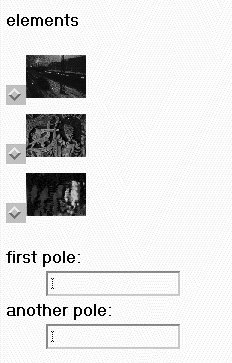In 1997, the Programme Systems Institute of Russian Academy of Science and CYPRES research centre (France) made a common research along two lines:
Staging of the first theater play by students of the School of Arts (Aix-en-Provence, France) and students from Theater Institute (Yaroslavl, Russia) made clear that the basic problems of the remote partners interaction are of cognitive rather than technical nature. We tend to use different elements for web-site design, different blocks for constructing robots, different mental constructs for situation analysis and for art production. In order to make a joint production it is necessary that the building elements and mental constructs used by one partner be clearly understood by the other.
In this world we always use categories that help us make it simpler and fit into a certain understandable system. Like rods can form a grid, some of these categories interlace to form structures, either individual, or related to a group or profession, that may have different names - systems of categories, category and value hierarchies, paradigms, etc. - but always serve practical purposes. Through these structures, or grids, we see the world around us and make judgments about other people actions; based on these grids, we generate our own behaviour and create things (be it scientific works, pieces of art, or whatever).The metaphor of a grid is quite to the point as we can talk about different elements a grid consists of. Different kinds of rods form different grids, and, what is probably more important, different type of weaving can result in making quite different grids out of the same rods. Now when we are at the outset of mastering the hypertext culture, we need to collect as many constructs as possible, since without the rods as the basic elements of culture no grid at all can be built.
Any element (construct) of a grid has two ends: beautiful - ugly, top - bottom, etc. Sometimes we use a construct having specified just one of its poles, e.g. "WEBNESS". In such a case the existence of the other pole - "Non-WEBNESS" - is implied. Some constructs are in common use, others are used by a narrow circle of professionals. There are even such that only one or two can understand. In order to grasp what another person means we have to look at the world through the rods of his or her grid. This is where the repertory grid techniques will help us.
The research involved Russian and French students and professional experts. By way of elements we took several videos from the Gallery of modern Russian video-art and several web-sites from the hypertext of Annick Bureau. A user was asked to classify videos, giving each a description in the terms (constructs) of his/her choice, and ranging the videos relative to every single construct. Fragments of all videos or web-sites were available to the user.
 |
Now, we can start construct acquisition:
We show three elements, and ask a question: Please, propose different poles of the scale which differ one of the elements from two another |
It is supposed that every time, a method can be offered to a user which would let him/her see the films from a different prospective, and thus produce a different classification of the same videos. Running this procedure several times yields a collection of "rods" that is in real use by people. The collection is available for reviewing.
The substantial difference between novice's and expert's grids lies not so much in the number of constructs as in the way they are "interwoven" and in the structures they produce. These structures form a professional cognitive model that an expert uses to build up a differentiated and structured picture. Worthy of note is that matching one's cognitive model with a model of a professional expert has a major educational meaning. This is one of the efficient ways of becoming proficient.
Project is granted by the Russian Foundation for Human Sciences Resarch N 96-04-12067B